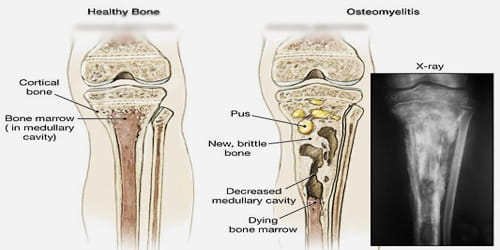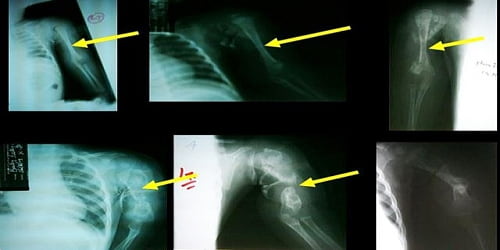Osteomyelitis (Causes, Risk Factors, Complications, and prevention)
Definition: Osteomyelitis (OM), also called a bone infection, is an infection and inflammation of the bone or the bone marrow. It can happen if a bacterial or fungal infection enters the bone tissue from the bloodstream, due to injury or surgery. Symptoms may include pain in a specific bone with overlying redness, fever, and weakness. The long bones of the arms and legs are most commonly involved in children, while the feet, spine, and hips are most commonly involved in adults.
The cause is usually a bacterial infection; rarely, a fungal infection. It may occur by spread from the blood or from surrounding tissue. Risks for developing osteomyelitis include diabetes, intravenous drug use, prior removal of the spleen, and trauma to the area. Diagnosis is typically suspected based on symptoms. This is then supported by blood tests, medical imaging, or bone biopsy.
In children, osteomyelitis most commonly affects the long bones of the legs and upper arms. Adults are more likely to develop osteomyelitis in the bones that make up the spine (vertebrae). People who have diabetes may develop osteomyelitis in their feet if they have foot ulcers.
Bone infections (osteomyelitis) can happen suddenly or develop over a long period of time. If they’re not properly treated, bone infections can leave a bone permanently damaged.

Causes and Risk factors of Osteomyelitis: Most cases of osteomyelitis are caused by staphylococcus bacteria, types of germs commonly found on the skin or in the nose of even healthy individuals.
When an infection develops inside the bone, the immune system will try to kill it. Neutrophils, a type of white blood cell, will be sent to the source of the infection to kill the bacteria or fungus. If the infection takes hold and is not treated, dead neutrophils will accumulate inside the bone, forming an abscess, or pocket of pus.
The most common cause of bone infections is S. aureus bacteria. These bacteria commonly appear on the skin but don’t always cause health problems. However, the bacteria can overpower an immune system that’s weakened by disease and illness. These bacteria can also cause infections in injured areas.
Our bones are normally resistant to infection. For osteomyelitis to occur, a situation that makes our bones vulnerable must be present. People at higher risk may have:
- A weakened immune system, due, for example, to chemotherapy or radiation treatment, malnutrition, dialysis, having a urinary catheter, injecting illegal drugs, and so on
- Circulatory problems, as a result of diabetes, peripheral arterial disease, or sickle cell disease
- A deep puncture wound or a fracture that breaks the skin
- Surgery to replace or repair bones
- Peripheral arterial disease (PAD)
- Smoking
Acute osteomyelitis is more common in children, while the spinal form is more common in patients aged over 50 years, and it is more common in males.

Complications and Prevention: Successful treatment of the infection is normally possible, but sometimes complications occur. Osteomyelitis complications may include:
- Bone death (osteonecrosis)
- Septic arthritis
- Impaired growth
- Skin cancer
Patients with a weakened immune system should:
- Have a well-balanced healthy diet and suitable exercise, to boost the immune system
- Avoid smoking, as this weakens the immune system and contributes to poor circulation
- Practice good hygiene, including regular and proper hand washing
- Have all the recommended shots
- Patients with poor circulation should:
- Avoid smoking, as it worsens the circulation
- Maintain a healthy body weight by following a healthy diet
- Exercise regularly to improve your circulation
- Avoid excessive regular alcohol consumption as this raises the risk of hypertension, or high blood pressure, and high cholesterol
People who are susceptible to infections should be especially careful to avoid cuts and scrapes. Any cuts or scrapes should be cleaned at once, and a clean dressing put over it.
Information Source:
















